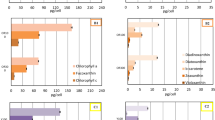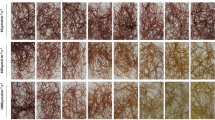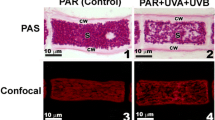Abstract
The change in the pigment composition of the unicellular alga Dunaliella parva 19/9 during exposure to high light (4000 μmol m-2 s-1) has been investigated. During photobleaching the carotenoids were lost at a greater rate than the chlorophylls. In these photoinhibitory conditions, β-carotene and especially the minor carotenes, δ- and γ-carotene, were more susceptible to oxidative destriction than the xanthophylls. Lutein, the major carotenoid present, was the most stable of the carotenoids in these conditions. In addition to the direct photobleaching of carotenoids and chlorophylls, high light treatment induced the de-epoxidation of violaxanthin to antheraxantin and zeaxanthin. Small amounts of zeaxanthin were present in cells prior to illumination but the amount increased 2.4 fold following high light treatment. The effects of extremes of temperature during exposure to high light intensities were also investigated. The destruction of chlorophylls was found to be more temperature sensitive than that of the carotenoids. The general pattern of loss for the individual carotenoids was similar to that found at 25°C, i.e., the carotenes were more readily degraded than the xanthophylls.
Similar content being viewed by others
References
Ashikawa I, Kito M, Satoh K, Koike H, Inoue Y, Saiki K, Tsukida K and koyama Y (1987) All-trans β-carotene-5,6-epoxide in thylakoid membranes. Photochem Photobiol 46: 269–275
Barry P (1988) Factors affecting carotenoid content and composition of higher plant tissues. Ph.D. thesis, University of Liverpool, England
Barry P, Young AJ and Britton G (1990) Photodestruction of pigments in higher plants by herbicide action I. The effect of DCMU (Diuron) on isolated chloroplasts. J Exp Bot 41 (223): 123–129
Britton G and Young AJ (1990) Carotenoids and plant stress. In: Alscher R, Amther J and Cumming JR (eds) Stress Responses in Plants, Adaptive Mechanisms. New York: Alan R. Liss Inc: (in press)
Cogdell R (1988) The functions of pigments in chloroplasts. In: Goodwin TW (ed) Plant Pigments, pp 183–230. London: Academic Press
Demmig-Adams B (1990) Zeaxanthin-associated energy dissipation and the susceptibility of various organisms to light stress. In: Proceedings of the VIIIth International Congress on Photosynthesis, Stockholm 1989. Dordrecht: Kluwer Academic Publishers (In press)
Demmig B, Winter K, Krüger A and Czygan F-C (1987) Photoinhibition and zeaxanthin formation in intact leaves. Plant Physiol 84: 218–224
Demmig B, Winter K, Krüger A and Czygan F-C (1988) Zeaxanthin and the heat dissipation of excess light energy in Nerium oleander exposed to a combination of high light and water stress. Plant Physiol 87: 17–24
Fork DC, Sen A and Williams WP (1987) The relationship between heat-stress and photobleaching in green and blue-green algae. Photosynth Res 11: 71–87
Kyle DJ (1987) The biomechanical basis for photoinhibition of photosystem II. In: Kyle DJ, Osmond CB and Arntzen CJ (eds) Photoinhibition, Topics in Photosynthesis 9: 197–226. Amsterdam: Elsevier
Neale PJ (1987) Algal photoinhibition and photosynthesis in the aquatic environment. In: Kyle DJ, Osmond CB and Arntzen CJ (eds) Photoinhibition, Topics in Photosynthesis 9: 39–66. Amsterdam: Elsevier
Rees D, Young AJ, Noctor G, Britton G and Horton P (1989) Enhancement of the ΔpH-dependent dissipation of excitation energy in spinach chloroplasts by light activation; correlation with the synthesis of zeaxanthin. FEBS Lett 256: 85–90
Siefermann-Harms D (1985) Carotenoids in photosynthesis. I. Location in photosynthetic membranes and light-harvesting function. Biochim Biophys Acta 811: 325–355
Siefermann-Harms D (1987) The light-harvesting and protective functions of carotenoids in photosynthetic membranes. Physiol Plant 69: 561–568
Williams WP, Sen A and Fork DC (1986) Selective photobleaching of PS I-related chlorophylls in heat stressed pea chloroplasts. Photosynth Res 10: 75–92
Yamamoto HY (1979) Biochemistry of the violaxanthin cycle in higher plants. Pure Appl Chem 51: 639–648
Young AJ, Barry P and Britton G (1989) The occurrence of β-carotene-5,6-epoxide in the photosynthetic apparatus of higher plants. Z Naturforsch 44c: 959–965
Young AJ and Britton G (1990) Effects of stress on chloroplast carotenoids. In. Proceedings of VIIIth International Congress on Photosynthesis, Stockholm 1989. Dordrecht: Kluwer Academic Publishers (In press)
Author information
Authors and Affiliations
Rights and permissions
About this article
Cite this article
Young, A., Britton, G. Photobleaching in the unicellular green alga Dunaliella parva 19/9. Photosynth Res 25, 129–136 (1990). https://doi.org/10.1007/BF00035461
Received:
Accepted:
Issue Date:
DOI: https://doi.org/10.1007/BF00035461




